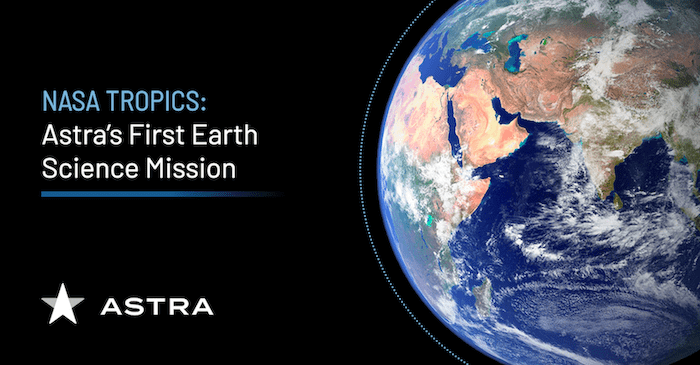
In February, NASA awarded Astra the launch contract for the TROPICS mission. This innovative Earth Science mission consists of a constellation of six small satellites that will observe tropical cyclones, aiming to improve the scientific community’s understanding of these dangerous weather events.
To learn more about what this mission will enable, we hosted a Tech Talk at Astra with Dr. William Blackwell, the principal investigator for the NASA TROPICS mission and a Group Leader at MIT’s Lincoln Laboratory.
“The mission that we are trying to accomplish with TROPICS is enabled by you all,” Blackwell told the Astra team during the town hall conversation. “The trade space of these missions is completely changed with the advent of on-demand, dedicated affordable launch. It’s a complete game changer, and it lets us do our mission.”
The TROPICS mission, according to Blackwell, represents an innovative step for NASA as it seeks to monitor and gather data on tropical cyclones. These storms have long presented challenges for scientists given that they are “notoriously difficult to observe and yet vitally important to our everyday lives,” he explained.
“We’re thrilled to be able to field this mission and work with [Astra] to get us up where we need to go to make the measurements that we need,” Blackwell told the team.
“You’re going to see a lot more missions like this now,” he said, adding that a successful TROPICS mission could “change the way scientists think about a portion of the Earth-observing portfolio.”
We caught up with Dr. Hemant Chaurasia, Astra’s Vice President of Product Management, to discuss Blackwell’s presentation and how TROPICS relates to our future missions. He broke down some of the key points:
What’s the most exciting thing about Astra’s involvement with TROPICS?
We are thrilled to be partnering with NASA, MIT, and the whole TROPICS team on this mission. TROPICS fits perfectly with Astra’s own mission to improve life on Earth from space. There remains much to learn about the tropical storms that this mission will study, and yet they have a huge impact on the daily lives of millions of people around the world. The six satellites we’re launching will improve our scientific understanding of these storms and materially improve lives.
It’s also exciting for us to see how well the TROPICS mission fits with our product at Astra – it makes full use of the flexibility, responsiveness, and affordability that sets our launch service apart.
On a personal level, I find it particularly inspiring to work on a project that will benefit the entire world. Not many companies get to do that with their products.
What’s most challenging about the TROPICS mission?
The biggest challenge (and opportunity) is the particular orbits that the TROPICS satellites need to get to. Tropical cyclones only occur in certain parts of the world (never near the equator or towards the poles), so the six NASA TROPICS satellites can’t go just anywhere. To get the data they need, they need to be launched into three different low inclination orbits, carefully spread apart from each other. These orbits allow the satellites to cover the right latitudes for tropical storms, while also maximizing how often they revisit a given storm each day – so we learn as much as we can about how those storms evolve.
Getting to those required orbits is the hard part for a launch provider. Most launch vehicles are far too expensive to launch these six small satellites as a set of dedicated missions. While it’s more affordable to fly as a rideshare payload on a large launch vehicle, these rideshare launches only go to the most common orbits, not the low inclinations needed for TROPICS. There are in-space propulsion systems that can help cover the “last mile” to the final orbit, starting from a rideshare orbit – but for where TROPICS needs to go, this would be too expensive or impractical, and is generally slow.
What makes Astra such a good fit for TROPICS?
We designed our launch system from the outset for flexible, affordable, and frequent launch of small satellites. For TROPICS, this means we can affordably provide not one, but three dedicated launches, directly to each of the three orbits needed for the TROPICS mission, all within 120 days. This would be much harder to pull off with any other company’s product – other dedicated launch options are too expensive, and rideshare launches don’t go anywhere near these orbits.
Why is the TROPICS mission important to the space industry?
As Dr. Blackwell pointed out, we expect to see many more missions like this: smaller, smarter satellites delivering useful data and connectivity from low Earth orbit. TROPICS demonstrates that the full value of these missions is unlocked when satellites are delivered quickly and affordably to the most useful orbits for the particular application. We designed our product to provide this new level of flexibility, across many applications.
All of this applies at a grand scale in the new wave of mega-constellations such as OneWeb, Amazon Kuiper, and SpaceX’s Starlink. These constellations aim to provide broadband internet connectivity for everyone, everywhere, using tens of thousands of small satellites in low Earth orbit. However, ensuring continuous service can be an expensive challenge, given that satellites can fail on orbit and leave critical gaps in coverage. One efficient solution is to use a dedicated small launch service to quickly launch satellites exactly when and where they need to go, whether those are development units or replacements for failed satellites.
This is just one of the applications we foresee as the space economy takes off in the years ahead, building global services on constellations of small satellites in low Earth orbit.
If you’re interested in making these missions possible, we’re hiring.